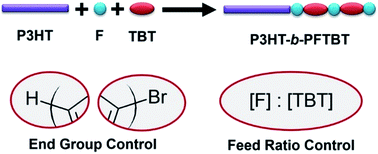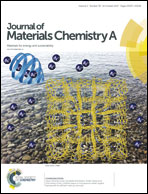Tuning the synthesis of fully conjugated block copolymers to minimize architectural heterogeneity†
Abstract
Conjugated block copolymers simultaneously control the mesoscale morphology and interfacial structure of the active layer in organic electronic devices. Fully conjugated block copolymers, where both backbones are conjugated, are commonly synthesized in two steps. First, poly(3-alkylthiophene-2,5-diyl) (P3HT) is synthesized by Kumada catalyst transfer/Grignard metathesis polymerization. The second block, typically a push–pull alternating copolymer, is added on to the P3HT macroreagent in a chain-extension reaction using either a Suzuki or a Stille polycondensation. Consequently, products can be a mixture of homopolymers, diblock copolymers, and multi-block copolymers. We demonstrate the optimum reaction conditions for the two-step synthesis of poly(3-hexylthiophene-2,5-diyl)-block-poly((9,9-bis-(2-octyl)fluorene-2,7-diyl)-alt-(4,7-di(thiophene-2-yl)-2,1,3-benzothiadiazole)-5′,5′′-diyl) (P3HT-b-PFTBT), a block copolymer that can be used as the sole active-layer material in organic photovoltaic devices. In the first reaction, preventing excess Grignard reagent to avert excess in the stoichiometry between Grignard reagent and monomer ensures end-group control of the P3HT macroreagent. In the second reaction, asymmetric monomer feed ratios with excess fluorene promotes coupling of PFTBT to P3HT. Using P3HT-b-PFTBT as an example, we demonstrate the synthetic parameters that are important to produce diblock copolymers with minimal impurities. This, in turn, promotes microphase separation in block copolymer films and leads to enhanced power conversion efficiencies in block copolymer solar cell devices.



 Please wait while we load your content...
Please wait while we load your content...